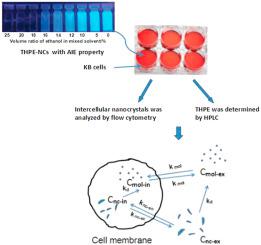Acta Pharmaceutica Sinica B ( IF 14.7 ) Pub Date : 2020-10-14 , DOI: 10.1016/j.apsb.2020.09.017 Jifen Zhang , Clairissa D. Corpstein , Tonglei Li

|
Nanocrystal formulations have been explored to deliver poorly water-soluble drug molecules. Despite various studies of nanocrystal formulation and delivery, much more understanding needs to be gained into absorption mechanisms and kinetics of drug nanocrystals at various levels, ranging from cells to tissues and to the whole body. In this study, nanocrystals of tetrakis (4-hydroxyphenyl) ethylene (THPE) with an aggregation-induced emission (AIE) property was used as a model to explore intracellular absorption mechanism and dissolution kinetics of nanocrystals. Cellular uptake studies were conducted with KB cells and characterized by confocal microscopy, flow cytometry, and quantitative analyses. The results suggested that THPE nanocrystals could be taken up by KB cells directly, as well as in the form of dissolved molecules. The cellular uptake was found to be concentration- and time-dependent. In addition, the intracellular THPE also could be exocytosed from cells in forms of dissolved molecules and nanocrystals. Kinetic modeling was conducted to further understand the cellular mechanism of THPE nanocrystals based on first-order ordinary differential equations (ODEs). By fitting the kinetic model against experimental measurements, it was found that the initial nanocrystal concentration had a great influence on the dynamic process of dissolution, cellular uptake, and exocytosis of THPE nanocrystals. As the nanocrystal concentration increased in the culture media, dissolution of endocytosed nanocrystals became enhanced, subsequently driving the efflux of THPE molecules from cells.
中文翻译:

细胞内摄取纳米晶体:聚集诱导的荧光发射和动力学模型的探索
已经探索出纳米晶体制剂来递送水溶性差的药物分子。尽管对纳米晶体的配制和递送进行了各种研究,但仍需要对药物纳米晶体在从细胞到组织再到整个身体的各个水平上的吸收机理和动力学进行更多的了解。在这项研究中,具有聚集诱导发射(AIE)特性的四(4-羟苯基)乙烯(THPE)纳米晶体被用作模型,以探索细胞内吸收机制和纳米晶体的溶解动力学。用KB细胞进行细胞摄取研究,并通过共聚焦显微镜,流式细胞术和定量分析进行表征。结果表明THPE纳米晶体可以直接被KB细胞吸收,也可以被溶解的分子吸收。发现细胞摄取是浓度和时间依赖性的。另外,细胞内THPE还可以以溶解的分子和纳米晶体的形式从细胞中胞吐。进行动力学建模以进一步了解基于一阶常微分方程(ODE)的THPE纳米晶体的细胞机理。通过将动力学模型与实验测量值进行拟合,发现初始纳米晶体浓度对THPE纳米晶体的溶解,细胞摄取和胞吐作用的动力学过程具有很大的影响。随着培养基中纳米晶体浓度的增加,内吞的纳米晶体的溶解变得增强,随后驱使THPE分子从细胞中流出。细胞内THPE也可以以溶解的分子和纳米晶体的形式从细胞中胞吐。进行动力学建模以进一步了解基于一阶常微分方程(ODE)的THPE纳米晶体的细胞机理。通过将动力学模型与实验测量值进行拟合,发现初始纳米晶体浓度对THPE纳米晶体的溶解,细胞摄取和胞吐作用的动力学过程具有很大的影响。随着培养基中纳米晶体浓度的增加,内吞的纳米晶体的溶解变得增强,随后驱使THPE分子从细胞中流出。细胞内THPE也可以以溶解的分子和纳米晶体的形式从细胞中胞吐。进行动力学建模以进一步了解基于一阶常微分方程(ODE)的THPE纳米晶体的细胞机理。通过将动力学模型与实验测量值进行拟合,发现初始纳米晶体浓度对THPE纳米晶体的溶解,细胞摄取和胞吐作用的动力学过程具有很大的影响。随着培养基中纳米晶体浓度的增加,内吞的纳米晶体的溶解变得增强,随后驱使THPE分子从细胞中流出。进行动力学建模以进一步了解基于一阶常微分方程(ODE)的THPE纳米晶体的细胞机理。通过将动力学模型与实验测量值进行拟合,发现初始纳米晶体浓度对THPE纳米晶体的溶解,细胞摄取和胞吐作用的动力学过程具有很大的影响。随着培养基中纳米晶体浓度的增加,内吞的纳米晶体的溶解变得增强,随后驱使THPE分子从细胞中流出。进行动力学建模以进一步了解基于一阶常微分方程(ODE)的THPE纳米晶体的细胞机理。通过将动力学模型与实验测量值进行拟合,发现初始纳米晶体浓度对THPE纳米晶体的溶解,细胞摄取和胞吐作用的动力学过程具有很大的影响。随着培养基中纳米晶体浓度的增加,内吞的纳米晶体的溶解变得增强,随后驱使THPE分子从细胞中流出。和THPE纳米晶体的胞吐作用。随着培养基中纳米晶体浓度的增加,内吞的纳米晶体的溶解变得增强,随后驱使THPE分子从细胞中流出。和THPE纳米晶体的胞吐作用。随着培养基中纳米晶体浓度的增加,内吞的纳米晶体的溶解变得增强,随后驱使THPE分子从细胞中流出。











































 京公网安备 11010802027423号
京公网安备 11010802027423号